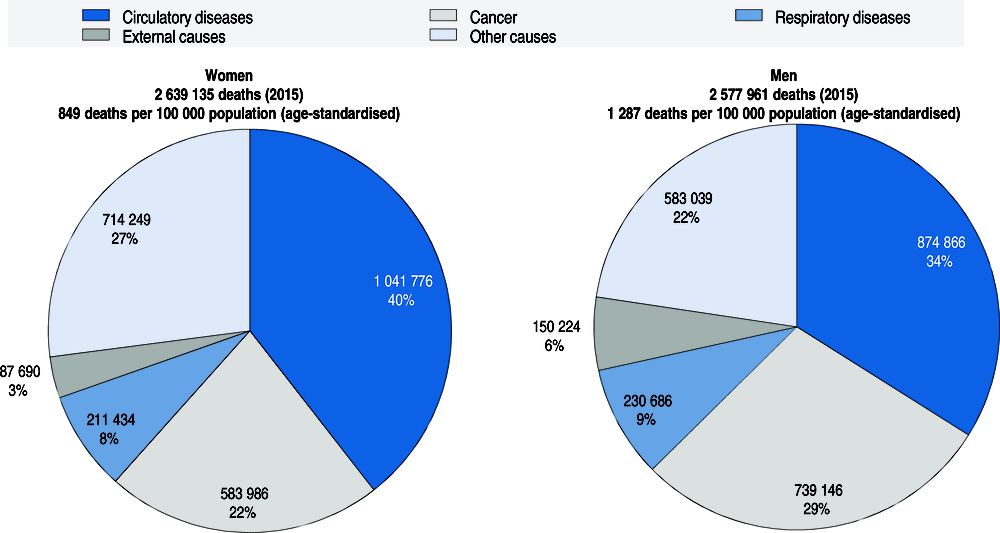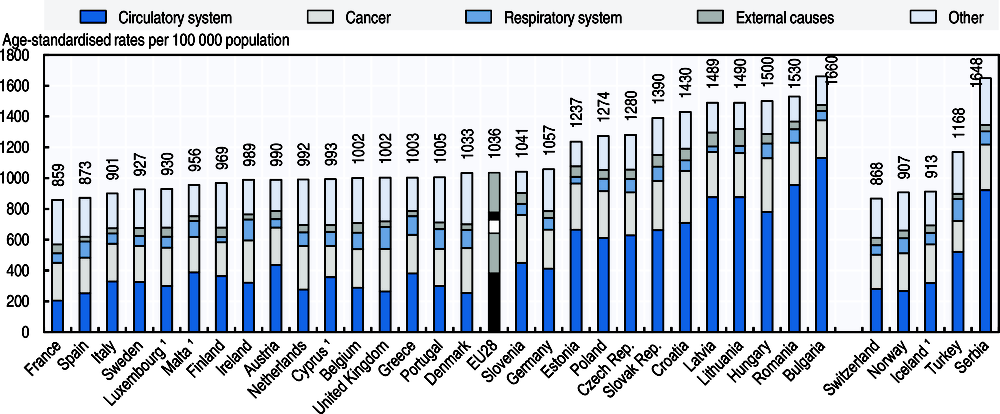Main causes of mortality
Over 5 200 000 people died in EU countries in 2015 (Figure 3.7). An unusual large increase in the number of deaths in 2015 explains the reduction in life expectancy in many countries compared with 2014 (see indicator “Trends in life expectancy”). The higher number of deaths in 2015 across EU countries was concentrated mainly among people aged 75 and over, and was attributed mainly to higher mortality from influenza and pneumonia triggering cardiorespiratory events, Alzheimer’s disease and other dementias, and heart diseases.
Slightly more women than men died across EU countries in 2015, as there are more women in the population, particularly in older age groups. Once the population structure is adjusted by age, the age-standardised mortality rate was about 50% higher among men across the EU as a whole (1 287 per 100 000 men compared with 849 per 100 000 women).
The main causes of death in EU countries are circulatory diseases and various types of cancer, followed by respiratory diseases and external causes of death.
Circulatory diseases continue to be the leading cause of death across the EU, accounting for over 1 900 000 deaths in 2015. Ischaemic heart diseases, which include heart attack and other diseases, and stroke are the most common causes of death from circulatory diseases (see indicator “Mortality from circulatory diseases”). The age-standardised mortality rate from circulatory diseases is much higher among men than women (about 40% higher), but nonetheless diseases of the circulatory system account for a greater share of deaths among women than men across EU countries.
Some 1 320 000 people died of cancer in 2015, accounting for 22% of all deaths among women and 29% of all deaths among men. Breast cancer and lung cancer are the leading causes of cancer death among women, whereas lung cancer and colorectal cancer are the two main causes of cancer death for men (see indicator “Mortality from cancer”).
After circulatory diseases and cancer, respiratory diseases are the third leading cause of death in EU countries, causing some 440 000 deaths in 2015, with the vast majority of these deaths occurring among people aged over 65. This group of diseases accounted for 8% of all death among women and 9% among men. Chronic obstructive pulmonary disease (COPD) is the most common cause of mortality among respiratory diseases, followed by pneumonia (see indicator “Mortality from respiratory diseases”).
External causes of death, which include accidents, suicides, homicides and other violent causes of death, were responsible for 3% of all deaths among women and 6% of deaths among men in EU countries in 2015. The most important causes of violent deaths are road traffic accidents and other accidental deaths, and suicides. Road traffic accidents are a particularly important cause of death among young people (aged 18-25), whereas suicide rates generally increase with age.
More than 80% of all deaths in EU countries occur after the age of 65. While the main cause of death among people aged over 65 is circulatory diseases, the main cause for people under 65 is cancer, particularly among women (Eurostat, 2018).
Overall mortality rates vary widely across countries. France, Spain and Italy have the lowest death rates, with age-standardised rates between 850 and 900 deaths per 100 000 population in 2015 (Figure 3.8). This was mainly due to relatively low mortality rates from circulatory diseases. Mortality rates are highest in Bulgaria, Romania and Hungary, with age-standardised rates at least 50% higher than the EU average in 2015. The main reason for this much higher mortality rate in Bulgaria and Romania is higher mortality rates from circulatory diseases. In Hungary, higher mortality rates from cancer explain a large part of the difference with the EU average.
Deaths from all causes are classified to ICD-10 codes A00-Y89, excluding S00-T98. Mortality rates are based on the number of deaths registered in a country in a year divided by the population. The rates have been age-standardised to the revised European standard population adopted by Eurostat in 2012 to remove variations arising from differences in age structures across countries and over time.
Reference
Eurostat (2018), “Causes of Death Statistics – People Over 65”, Statistics Explained, European Commission, April.


